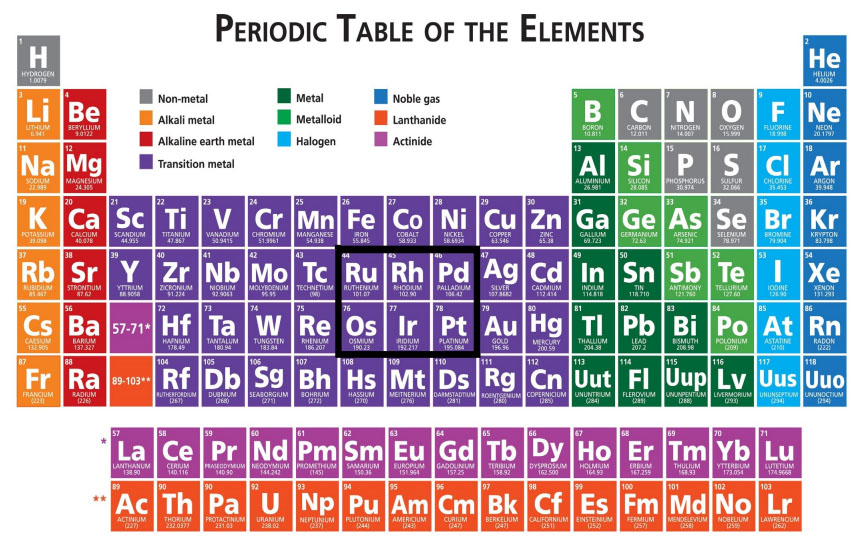Platinum and 150 Years of the Periodic Table
Posted:
The modern periodic table was first created 150 years ago, enabling the classification of chemical elements for the first time, including the Platinum Group Metals
Created by Russian chemist Dmitri Ivanovich Mendeleev in 1869, the periodic table is one of the most important developments in the history of chemistry. It describes the atomic properties of every known chemical element in a concise format, including its atomic number, atomic mass and relationship with other elements.
By the time of Mendeleev’s breakthrough discovery, the Platinum Group Metals (PGMs) – platinum, palladium, rhodium, ruthenium, iridium and osmium – had already been identified as separate elements, albeit derived from the same ore. All six PGMs were included in Mendeleev’s original version of the periodic table.
Within the periodic table, elements with similar chemical properties are arranged in 18 columns called groups. The seven rows of the table, called periods, generally have metals on the left and non-metals on the right.
Prior to Mendeleev’s discovery, chemists had already recognized patterns in the properties of elements and were looking for ways of arranging the elements to reflect these similarities.
However, Mendeleev was the first to establish a method of classification which arranged the chemical elements by increasing relative atomic mass ‘periodically’, that is in a way that shows a pattern in chemical or physical properties. The modern periodic table lists the elements in order of increasing atomic number (the number of protons in the nucleus of an atom).
The creation of the periodic table has enabled not only the identification of matter already discovered by humankind, but also the classification of new matter. The atomic structure of new matter can be compared to the existing elements in the table in order to work out which family it is closest to and how it is likely to behave.
In 1869, the periodic table contained 63 elements compared to 118 today, with the most recent additions having been made in 2016 with the inclusion of four new elements.
Platinum and the periodic table

Chemical elements are the atomic building blocks of the universe, playing a vital role in our daily lives. By using the periodic table, elements can be grouped into particular families that have similar characteristics.
Platinum and its sister metals are one such family of elements within the periodic table. Clustered together, these elements are all ‘transition’ metals in groups eight, nine and ten, and periods five and six, adjacent to the other precious metals, gold and silver.
Transition metals are generally hard and dense, and less reactive than the alkali metals. They also have catalytic properties and are good conductors of heat and electricity.
As the data on the periodic table shows, the PGMs share many properties and are used, either individually or in combination as alloys, in a multitude of applications from autocatalysts to fertilizer production, glass making, cloud computing and even cancer treatments.
Posted with permission of World Platinum Investment Council. As of February 20, 2019.


